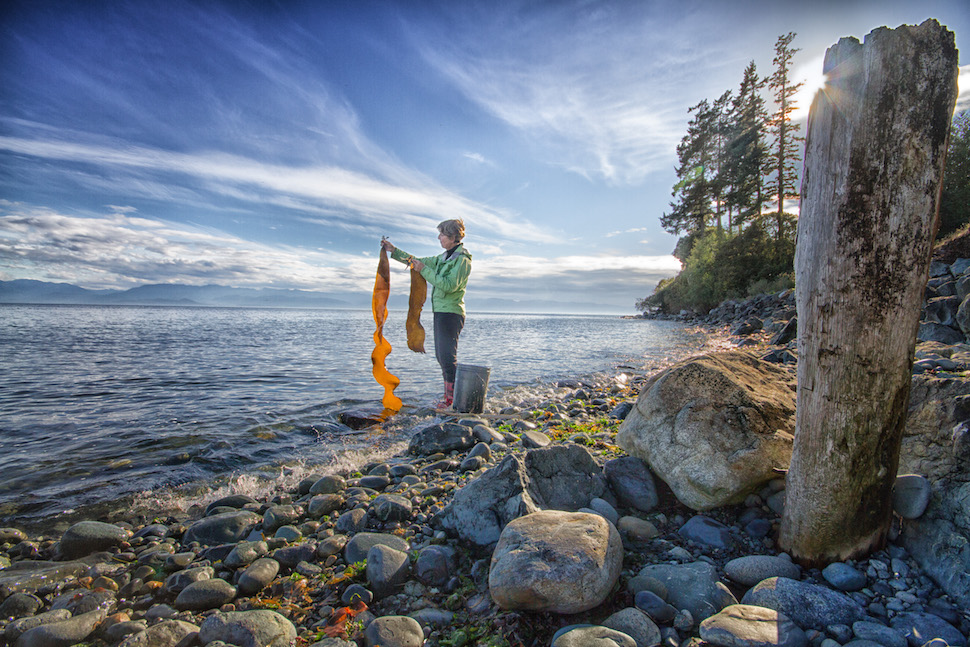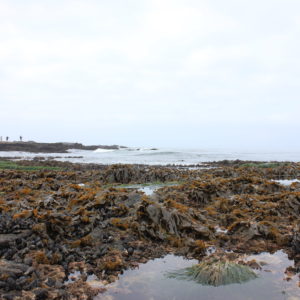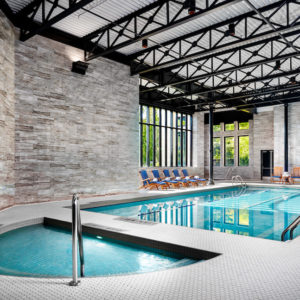
At Bilston Creek Farm, lavender growers and honey makers on Vancouver Island, about a half hour from graceful Victoria, I meet up with fourth generation seaweed forager and harvester, Adam Butcher. Shortly, we’ll be having a moveable feast of afternoon tea—scones and clotted cream cucumber sandwiches and such—ordered up from Fairmont Empress, one of the world’s most iconic spots to sip from a china cup. (Fun fact: Winston Churchill loved to tipple at tea time in the hotel’s grand lobby, though during prohibition he cheated a bit and secretly swilled gin from his teapot.) But, at the moment jam tarts and puffy pastries can’t compete with what Adam has laid on the table before me.
All in a line, exuding a crush of colors, from pink to green, bowls full of seaweed beckon. In various shapes from stringy to feathery to fat and lumpy, they rise in mounds and spill over as filamentous fingers and hefty blades onto the table. Some, have knobby leaves, others, snakelike, swirl labyrinthine-like inside their dish. One seems almost iridescent. Mesmerized, I suddenly fancy myself in a seamstress’ or milliner’s shop. I imagine that these bowls, full of so much texture, might be turned into hats or a complicated outfit, bits and pieces from the sea, needled into couture—perhaps becoming something a mermaid might wear.
The Super Powers of Seaweed
 But, that’s all in my head—mermaids and me dancing while donning seaweed. Adam’s talking to me. He doesn’t know I’m dreaming. “There are three misconceptions about seaweed, he says, professorially. “One: that it stinks—it doesn’t. Two: that it’s slimy.” He hands a piece over. “Feel it for yourself.” (It isn’t slimy, in fact, it is soft and sumptuous as velvet—and not stinky at all, either. I can’t stop myself rubbing it all along my arm.) “And, three—that it is a fish. Seaweed is not a fish.” Adam, CEO and Director of Seaflora Skincare, a shrewd company with a conscience, founded by his mother and father, Diane and George Butcher, seaweed visionaries. Set on the Salish Sea at Sooke British Columbia, on untrammeled Vancouver Island, Seaflora grew from Diane’s notion that if seaweed had superfood status consumed down the gullet, it surely could benefit the skin, as well. Foragers had long noticed the softening effect these plants had on their skin as they gathered them from the water. Aware that other seaweed products out there hold only trace amounts of seaweed, Diane, known locally as “the seaweed lady,” developed revolutionary methods to put whole, wild, organic, raw, seaweed into lotions and elixirs. The resulting concoctions reign as premium products that have visible, lasting, instant results. Unlike other seaweed potions, Seaflora’s products brim with ponderous, health-supporting sea plant powers. Non-toxic, fragrance-free, they contain none of the harmful ingredients commonly used in the beauty industry.
But, that’s all in my head—mermaids and me dancing while donning seaweed. Adam’s talking to me. He doesn’t know I’m dreaming. “There are three misconceptions about seaweed, he says, professorially. “One: that it stinks—it doesn’t. Two: that it’s slimy.” He hands a piece over. “Feel it for yourself.” (It isn’t slimy, in fact, it is soft and sumptuous as velvet—and not stinky at all, either. I can’t stop myself rubbing it all along my arm.) “And, three—that it is a fish. Seaweed is not a fish.” Adam, CEO and Director of Seaflora Skincare, a shrewd company with a conscience, founded by his mother and father, Diane and George Butcher, seaweed visionaries. Set on the Salish Sea at Sooke British Columbia, on untrammeled Vancouver Island, Seaflora grew from Diane’s notion that if seaweed had superfood status consumed down the gullet, it surely could benefit the skin, as well. Foragers had long noticed the softening effect these plants had on their skin as they gathered them from the water. Aware that other seaweed products out there hold only trace amounts of seaweed, Diane, known locally as “the seaweed lady,” developed revolutionary methods to put whole, wild, organic, raw, seaweed into lotions and elixirs. The resulting concoctions reign as premium products that have visible, lasting, instant results. Unlike other seaweed potions, Seaflora’s products brim with ponderous, health-supporting sea plant powers. Non-toxic, fragrance-free, they contain none of the harmful ingredients commonly used in the beauty industry.
Foragers had long noticed the softening effect these plants had on their skin as they gathered them from the water.
Why seaweed and why seaweed from British Columbia? First of all, the frigid Salish Sea (the all-encompassing name for the waterways that compose the fjord-like region that fringes the coast of British Columbia) has long been known for its unpolluted, mineral-rich waters. In them, hundreds of species of seaweed grow and thrive—including at least one, iridaea cordata, that only appears in these waters. As it turns out, seaweed leads the vegetable kingdom in mineral and vitamin largesse. The plants, bathing in the sea, absorb the water’s minerals in their pure ionic form, which makes them more bio-available to our bodies. Whether ingested or put on the skin, they free up the detox pathways, eliminate toxins, moisturize, re-mineralize, fight inflammation, and soothe. Add in that seawater mimics our own body fluids from tears to amniotic fluid, and seaweed begins to feel like a mythical nutrient.
A Subterranean Spa Haven
 At Fairmont’s historic The Empress, I descend into the Willow Stream spa, a subterranean haven that has some windows that show the garden and the sea. Mostly, though, the atmosphere exudes a sanctuary of quietude, a place to tune out the external world—if but for a few hours. Here, I meet curative Marion Mattingly, a spa therapist with extraordinarily restorative energy. Just meeting her grounds me. It’s as if she carries an energy tuning fork in her pocket. But when she lays hands (therapeutically) on me during my Seaflora Salish Sea Body Treatment, I know she has that rare extra layer of shamanic healing intuition that makes a difference in a spa. Under her guardianship, I’m scrubbed with sea mud, then sheathed in a seaweed-infused wrap. Wild seaweed leaves (later used as a chamois in the shower) have been placed in key places—such as atop my heart chakra. Marion’s scalp massage during the wrap nearly puts me to sleep, but rather than feeling relaxed, I feel re-charged, transfused with a kind of joyful contentedness, so we talk a bit. The finale, a sea kelp lotion, and seaweed gel massage complete my sense of being replenished spiritually. I feel like a light has been switched on inside. The added bonus: seriously soft and hydrated skin cannot be denied.
At Fairmont’s historic The Empress, I descend into the Willow Stream spa, a subterranean haven that has some windows that show the garden and the sea. Mostly, though, the atmosphere exudes a sanctuary of quietude, a place to tune out the external world—if but for a few hours. Here, I meet curative Marion Mattingly, a spa therapist with extraordinarily restorative energy. Just meeting her grounds me. It’s as if she carries an energy tuning fork in her pocket. But when she lays hands (therapeutically) on me during my Seaflora Salish Sea Body Treatment, I know she has that rare extra layer of shamanic healing intuition that makes a difference in a spa. Under her guardianship, I’m scrubbed with sea mud, then sheathed in a seaweed-infused wrap. Wild seaweed leaves (later used as a chamois in the shower) have been placed in key places—such as atop my heart chakra. Marion’s scalp massage during the wrap nearly puts me to sleep, but rather than feeling relaxed, I feel re-charged, transfused with a kind of joyful contentedness, so we talk a bit. The finale, a sea kelp lotion, and seaweed gel massage complete my sense of being replenished spiritually. I feel like a light has been switched on inside. The added bonus: seriously soft and hydrated skin cannot be denied.
Fairmont Empress, a castle on the water, has a long history on Vancouver Island. To stay here is to immerse in the past. Even as I posted photos of my visit, I heard from people of all ages who had made pilgrimages here, often decades ago, as children. Most still had a photograph of themselves at afternoon tea, which they sent over to show me. In that mode of how a grand hotel does define a location, Fairmont Empress’ Willow Stream Spa further reaches into the terrain with Seaflora products (and other locally inspired treatments) to evoke the Salish Sea, British Columbia’s terrain, people, and its coastline. The range of products offered, and especially the seaweed treatments, surely show how a visit to any spa can be one part of that cultural immersion all travelers seek.
Becca Hensley
Becca Hensley is Editor at Large for Insider's Guide to Spas. Based in Austin, she writes regularly about travel and spas. She believes a good story draws you in like laughter in a crowded room, and challenges you to do it justice. Her work appears regularly in Austin Monthly, Travel Channel, Toronto Star and National Geographic Traveler.